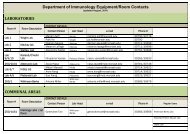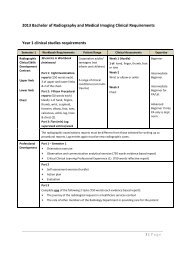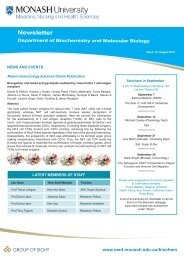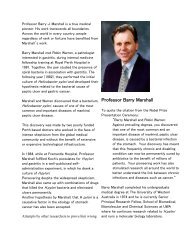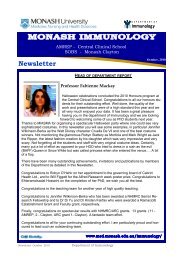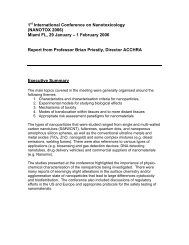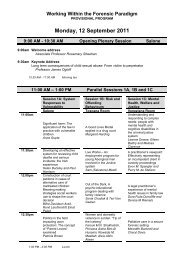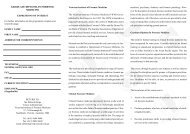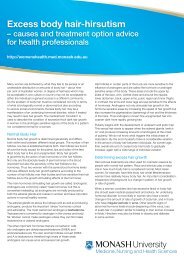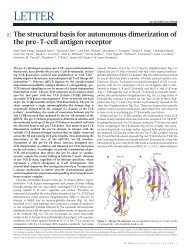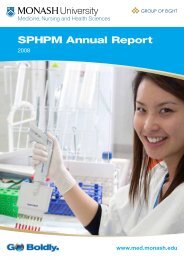Newsletter - Faculty of Medicine, Nursing and Health Sciences ...
Newsletter - Faculty of Medicine, Nursing and Health Sciences ...
Newsletter - Faculty of Medicine, Nursing and Health Sciences ...
You also want an ePaper? Increase the reach of your titles
YUMPU automatically turns print PDFs into web optimized ePapers that Google loves.
INTRODUCING: Dr Ruby Law<br />
<strong>Newsletter</strong>: April 2011, Issue 22<br />
Background<br />
I started my research career upon accepting a postgraduate scholarship in the Yeast Molecular Biology Group at<br />
the Department <strong>of</strong> Biochemistry, Monash University, working under the supervision <strong>of</strong> Pr<strong>of</strong>essors Rodney Devenish<br />
<strong>and</strong> Phillip Nagley. This was hard-core molecular biology! My project was focused on the functional relocation <strong>of</strong><br />
mitochondrial genes into the nucleus to explore the feasibility <strong>of</strong> correcting hereditary mitochondrial gene mutations<br />
causing diseases such as diabetes, muscle pain, deafness <strong>and</strong> blindness.<br />
After leaving this exciting work, I went along to acquire more skills working in a number <strong>of</strong> biotechnology projects, one<br />
<strong>of</strong> which was to produce the human glutamic acid decarboxylase GAD65 in the Autoimmunity Group lead by Pr<strong>of</strong>essors<br />
Merrill Rowley <strong>and</strong> Ian Mackay also in the Department <strong>of</strong> Biochemistry at Monash University. GAD65 is one <strong>of</strong> the<br />
auto-antigens found in Type 1 Diabetes <strong>and</strong> Stiff Person Syndrome, <strong>and</strong> one <strong>of</strong> the key enzymes that produce gamma amino-butyric acid (GABA), a<br />
neurotransmitter inhibitor in the CNS. Our aim was to generate large quantities <strong>of</strong> GAD65 protein for potential diagnostic development <strong>and</strong> therapeutic<br />
applications. I had a fantastic time building the GAD protein production “factory” whilst juggling to raise our young family. I am still not sure which one was<br />
more tricky.<br />
After the GAD project, I decided to do something a little different – working on worms looked good. I was attracted to a parasite called liver fluke because<br />
this parasite costs millions <strong>of</strong> dollars each year through loss <strong>of</strong> livestock production, stock deaths, human infections <strong>and</strong> costs <strong>of</strong> treatment <strong>and</strong> prevention.<br />
More importantly its main effect is in poor rural communities where animals are their main source <strong>of</strong> income (e.g. Buffalo for meat, milk <strong>and</strong> to plough<br />
their rice fields). For many years, detection <strong>of</strong> liver fluke infected livestock was not possible, especially in developing countries. I joined the Molecular<br />
Parasitology Group led by Pr<strong>of</strong>essor Terry Spithill, focused on expression <strong>and</strong> purification <strong>of</strong> fluke-proteins for the development <strong>of</strong> vaccines <strong>and</strong> diagnostic<br />
kits for fluke infections. The project was very stimulating <strong>and</strong> I learnt lots about the areas <strong>of</strong> vaccine development <strong>and</strong> parasite immunology. Although we<br />
didn’t develop a commercial vaccine <strong>and</strong> work is still ongoing, I was involved in the development <strong>of</strong> a diagnostic kit now used in Indonesia. This was very<br />
satisfying <strong>and</strong> I continue to help out with this research in my spare time (which isn’t a lot!).<br />
When my old boss picked up a new post in Canada as the director for the Centre for Host-Parasite Interactions at McGill University in 2003, Pr<strong>of</strong>essor<br />
James Whisstock had just started his new Structural Biology Group in the Department. He kindly invited me to join his laboratory <strong>and</strong> I moved back to the<br />
“hard-core” research projects, firstly working part-time <strong>and</strong> then gradually full-time, <strong>and</strong> have been part <strong>of</strong> his laboratory ever since (some might say I have<br />
become part <strong>of</strong> the Monash woodwork). It has been a fascinating experience from my point <strong>of</strong> view to see how he started with 2-3 people inside Pr<strong>of</strong>essor<br />
Rob Pike’s laboratory (with one power pack) to a large <strong>and</strong> fully equipped laboratory <strong>of</strong> more than 20 people. During this time I have again reinvented<br />
myself, switching from a protein chemist to a structural biologist, thanks to James’s patience <strong>and</strong> underst<strong>and</strong>ing. During the past many years, James has<br />
been a fantastic leader <strong>and</strong> mentor <strong>and</strong> I have learnt a lot <strong>and</strong> excitingly have been involved in several high impact publications. I have also been very<br />
fortunate to work closely many extraordinary colleagues who were always ready to help <strong>and</strong> share ideas. I owe my special thanks to our very supportive<br />
team <strong>of</strong> research assistants Adam Quek, Dharsh Jeevarajah <strong>and</strong> Gordon Lloyd, as well as those who have left the laboratory to develop their careers<br />
further. Below are some <strong>of</strong> the exciting projects I am currently involved with in the Whisstock laboratory.<br />
Projects<br />
Fibrinolytic system: This work is funded by NHMRC in collaboration with A/Pr<strong>of</strong>essor Paul Coughlin <strong>and</strong> Dr Anita Horvath from the Australian Blood<br />
Disease Centre; <strong>and</strong> Drs Tom Caradoc-Davis <strong>and</strong> Nathan Cowieson from the Australian Synchrotron. Plasminogen is the zymogen form <strong>of</strong> plasmin <strong>and</strong><br />
is the most formidable protease in the plasma. It is responsible for the removal <strong>of</strong> blood clots (fibrinolysis) in the circulating system in order to maintain<br />
the blood flow. As well as that, plasminogen can also bind to the surface <strong>of</strong> cells <strong>and</strong> become activated to plasmin, which breaks down the basement<br />
membrane <strong>and</strong> extra-cellular matrix hence promotes cell migration <strong>and</strong>, in the case <strong>of</strong> cancer, cell invasion. We crystallized <strong>and</strong> determined the crystal<br />
structure <strong>of</strong> plasminogen, <strong>and</strong> the results were recently published in Cell Reports (2012). The structure reveals how circulating plasminogen resists<br />
activation until it binds to a fibrin clot or target cell surface. It also explains how pathogens (such as Streptococcus) hijack this potent plasma protease<br />
during invasion. Our current focus is to underst<strong>and</strong> the molecular interactions during plasminogen activation <strong>and</strong> plasmin inhibitions, especially in disease<br />
conditions such as thrombosis <strong>and</strong> uncontrolled bleeding. We employ various techniques including mutagenesis, characterization <strong>of</strong> enzyme activities,<br />
protein complex formation, X-ray crystallography <strong>and</strong> small angle X-ray scattering.<br />
Structure <strong>and</strong> regulation <strong>of</strong> function <strong>of</strong> human glutamic decarboxylase (GAD): Gamma aminobutyric acid (GABA) produced by GAD is the most abundant<br />
neurotransmitter inhibitor in the CNS <strong>and</strong> is critical for the control <strong>of</strong> movements, <strong>and</strong> neuroplasticity during development, learning <strong>and</strong> recovery from brain<br />
damage. Neurological conditions, such as anxiety, autism <strong>and</strong> post-traumatic stress disorder, are closely related to the imbalance <strong>of</strong> GABA homeostasis.<br />
This project is a continuation <strong>and</strong> expansion <strong>of</strong> my previous work on the GAD project with Pr<strong>of</strong>essors Merrill Rowley <strong>and</strong> Ian Mackay. We published the<br />
crystal structures <strong>of</strong> both GAD65 <strong>and</strong> GAD67 is<strong>of</strong>orms in Nature Structure <strong>and</strong> Molecular Biology (2007). We observed that the mechanism through which<br />
GABA produced in mammals is regulated by a dynamic catalytic loop. The two is<strong>of</strong>orms <strong>of</strong> GAD cooperate to meet different physiological circumstances;<br />
GAD67 is a housekeeping enzyme which maintains the basal level <strong>of</strong> GABA in the CNS <strong>and</strong> stably binds to the c<strong>of</strong>actor pyridoxal 5’ phosphate (as a holoenzyme),<br />
whilst GAD65 switches between the apo <strong>and</strong> holo-form through a process called autoinactivation. The current project studies firstly, the structural<br />
motifs involved in the autoinactivation <strong>and</strong> secondly, small molecules which can modulate the rate <strong>of</strong> GAD activity. These studies involve measuring<br />
enzyme activity <strong>and</strong> using X-ray crystallography; with our outst<strong>and</strong>ing research assistant turned PhD student Chris Langendorf being the key contributor<br />
to this project. Our aim is to comprehensively underst<strong>and</strong> the process <strong>of</strong> auto-inactivation <strong>and</strong> allosteric regulation <strong>of</strong> GAD, with the long term aim <strong>of</strong><br />
developing therapeutic treatments for GAD neurological diseases through the modulation <strong>of</strong> GAD activities.<br />
Continued page 6<br />
Department <strong>of</strong> Biochemistry <strong>and</strong> Molecular Biology<br />
Page 5




